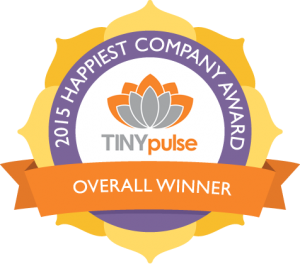In January of 2015 my team sat in a ski-in, ski-out lodge at the foot of the Rocky Mountains at Durango Mountain Resort on a Friday morning.
As we do from time-to-time, we were playing a game.
The game was to guess how well we ranked as an organization on happiness compared to over 700 organizations worldwide.
Ironically, we didn’t even realize we were being ranked against other teams when we anonymously rated our happiness at work every 6 weeks. We simply were doing it for our own internal tracking.
Why were we so intrigued by our team’s happiness? Because, in the words of a British study, happiness is more important than a high salary.
Back to our game…
Everyone had to privately write down where they thought we ranked.
The guesses ranged from 98 (top 16%) to 12 (top 2%).

To say we were shocked to be #1 overall would be an understatement.
How could we be #1?
This gathering in the Rocky’s was the first time many of our team members had ever seen each other in person.
We were spread across 4 time zones, only in business a few years, had no outside funding for a fancy cafeteria or even walking desks.
How can we be happier than the companies with walking desks!?
Firstly, we don’t TRY to be happy.
Seriously.
Happiness is a result not a goal.
And what makes people happy?
Being surrounded by people who care about them.
The #1 reason people stay at or leave a job is their relationship with their direct supervisor.
If your boss doesn’t care about you, you hate your job. Period.
Ok, but that’s obvious right?
The hard part is, what does it look like to care about your team? You know, without walking around giving overzealous hugs and trite praise.
Well that’s up to you as a leader.
How do you treat people who you care about?
For me, as the leader, I try to focus on a business-version of the Golden Rule.
“Give others the benefits, culture and environment I’d want.”
So even though we didn’t have a hip office loaded with bean bags and foosball (though that sure would be fun!), here’s what our 100% remote team does enjoy.
- A Players – After your relationship with your direct superior the next most important thing affecting happiness is your peers. If you don’t trust your peers are committed to doing quality work and have your back, your team’s happiness will tank.
- Ecstatic Customers – If you’ve ever had a job where your team failed to deliver upon your customers’ expectations so you regularly had to deal with upset customers, you know just how depressing it is to not have customers who love you.
- Integrity – We’re not perfect so we’ve made a few mistakes. A few of these mistakes the client would have never known about without us telling them. Even though it cost us thousands of dollars, we notified the customer, apologized for the mistake, and gave them a credit on their account. Integrity is not optional.
- Open Dialogue – This takes a lot of forms like our daily stand-ups, weekly team meetings and our monthly revenue reviews. However this also includes bi-weekly anonymous feedback via TINYpulse for some very tough questions like “Have you looked for another job in the last 6 months.” That one had me sweating a bit.
- Inclusive language – We don’t have a CEO or employees. We have a team leader and team members. We don’t have an annual “meeting” we have a retreat. We don’t have “performance reviews” we have 12 Questions Surveys where team members evaluate our leadership based on First, Break all the Rules by Marcus Buckingham.
- Constant communication – Slack, Trello, TINYpulse, Google Hangouts and Google Docs all contribute to regular feedback. Help is always at your fingertips without all of the distractions of a normal office.
- Written Purpose and Culture – Unless you have your culture and purpose in writing, you won’t ever be able to get everyone on your team committed to that culture.
- Continual Learning – Dan Pink, in his book Drive, calls this Mastery. Everyone wants to be great at something and they also want to keep getting better. Each team member can receive a free Kindle and has a $50 education budget to spend every month on books, online classes or seminars.
- Trust – Flexible schedules, unlimited vacation, group goal planning, shared revenue numbers. When you trust people you approach perks differently.
- Gratitude – Shortly after adding our 4th team member we started a program to donate to a charity each month. We weren’t a big, profitable company but we wanted to create a culture of gratitude and thanks for the blessings we did have. Since then the donation amount has grown 800% and we keep increasing it as we grow!
- Recognition – In First, Break all the Rules, Buckingham says one questions you need to ask your team quarterly is, “In the last 7 days have you received recognition at work?” TINYpulse has an awesome feature called Cheers for Peers where you can “call-out” someone on your team for a “cheers”. It’s a great way to recall the great things your team members do and let them know.
- Set Big Hairy Audacious Goals – You want to get people fired up, have them work together to win a superbowl. However, if you’re not running an NFL team, you need to create your own superbowl. Have long-term (5-10 year), middle term (3-5 year), and short term (annual and quarterly) goals that all align and get your team excited. The goals should be a bit uncomfortable. If they are too easy, there isn’t much to get fired up about! (Learn more about these BHAGS from Jim Collins in Good to Great.)
- Get people doing what they love and get out of the way! – When you let people succeed, they receive the twin benefits of having the freedom to run with ideas and seeing the direct impact of their actions.
- Objective feedback – This is not always comfortable but as Patrick Lencioni points out in The Five Dysfunctions of a Team, passive aggression will kill teamwork. Sometimes you have to do the uncomfortable task of “picking a fight” to make sure everything is on the table so it can be discussed and addressed.
- Test everything – Whether it’s a new value proposition, landing page, pricing strategy, bio-hack for productivity, tool for organizing your day or software package, we’re constantly testing. This way everyone knows all ideas are equally viable – as long as they are willing to prove it.
That’s a long list however nothing on that list is extremely complicated or hard to do. Keep in mind, the list is not exhaustive and certainly other happy companies will have slightly different lists particularly when it comes to the perks.
However, if you’re trying to create one of the Happiest Companies in the World, it’s not going to happen by accident.
Make a commitment to tackle one item on the list each month (or create your own list) and within a couple of years you won’t believe the transformation in your organization.
To happier companies,
Bryan
P.S. If you’re not sure how to prioritize your list, start by signing up for TINYpulse to get immediate feedback from your team while you read the 4 books I mentioned above.




